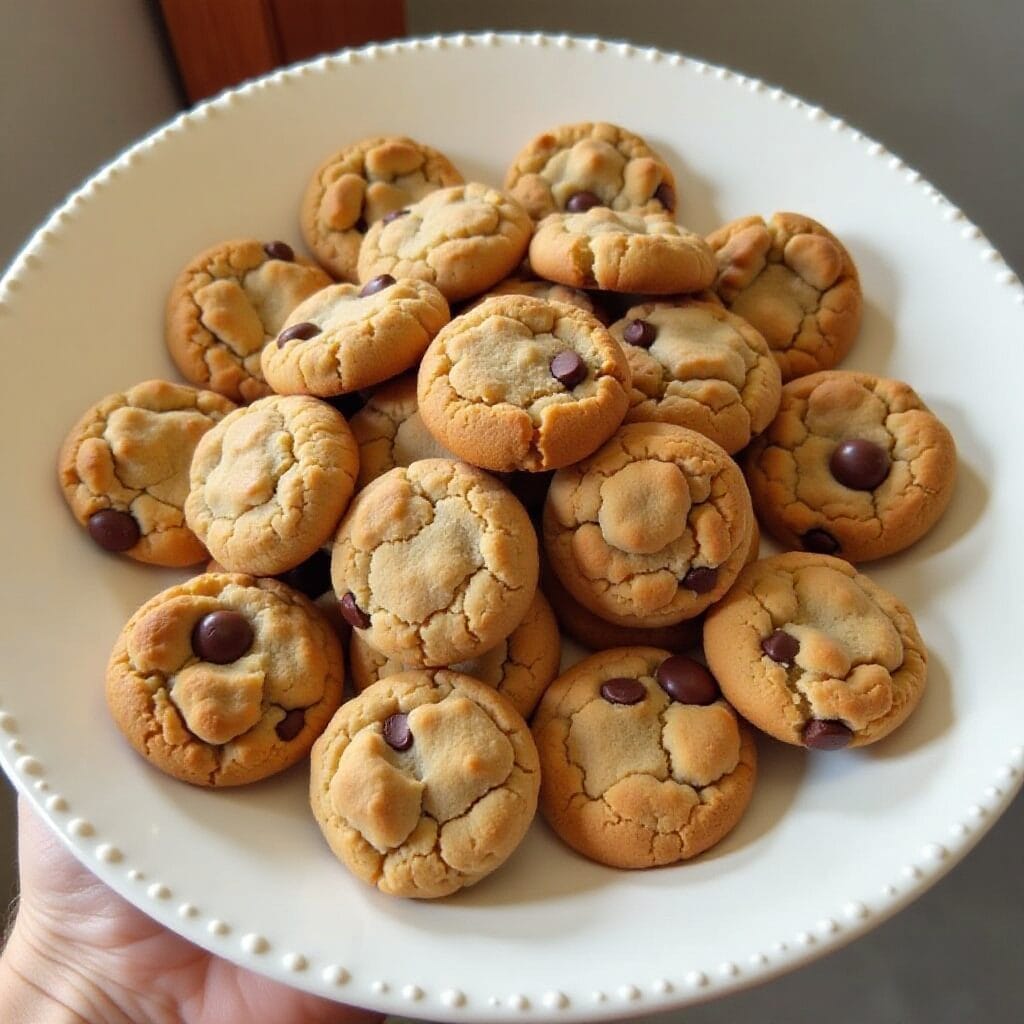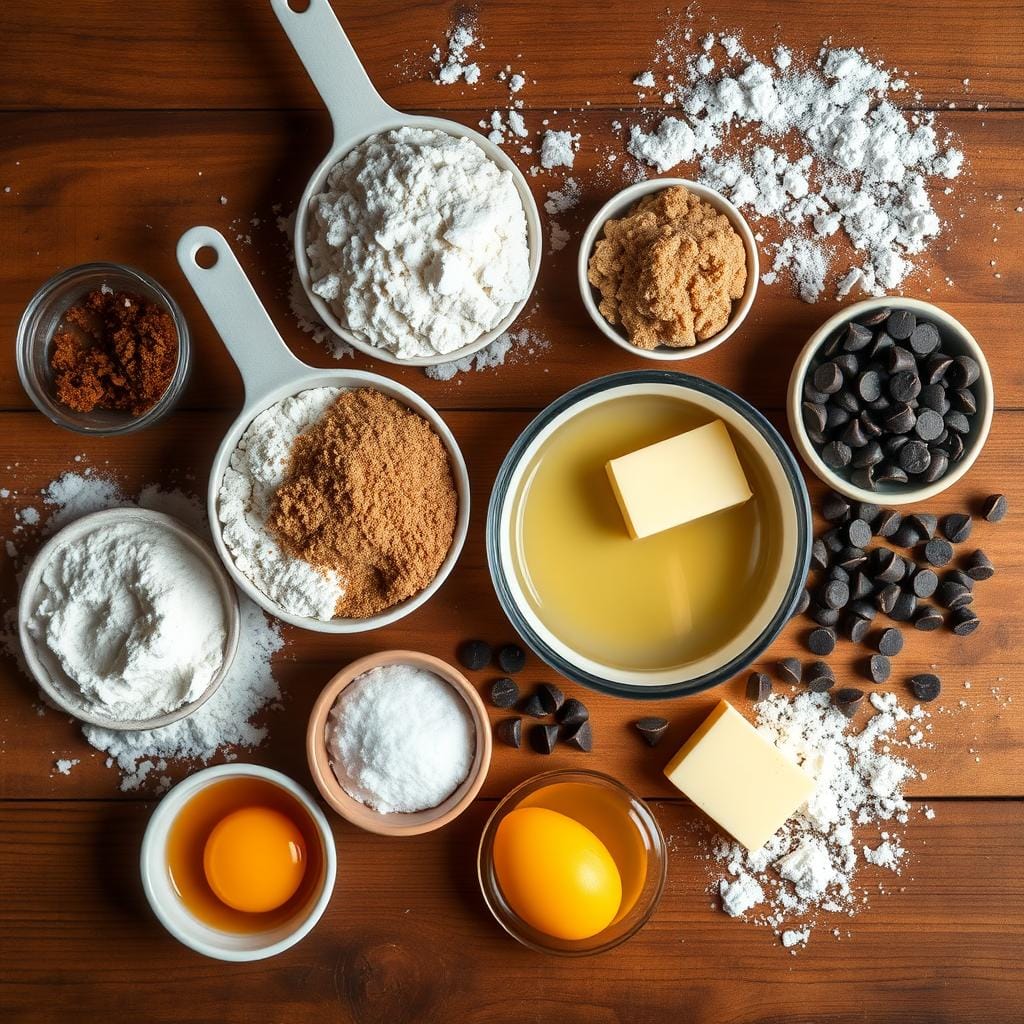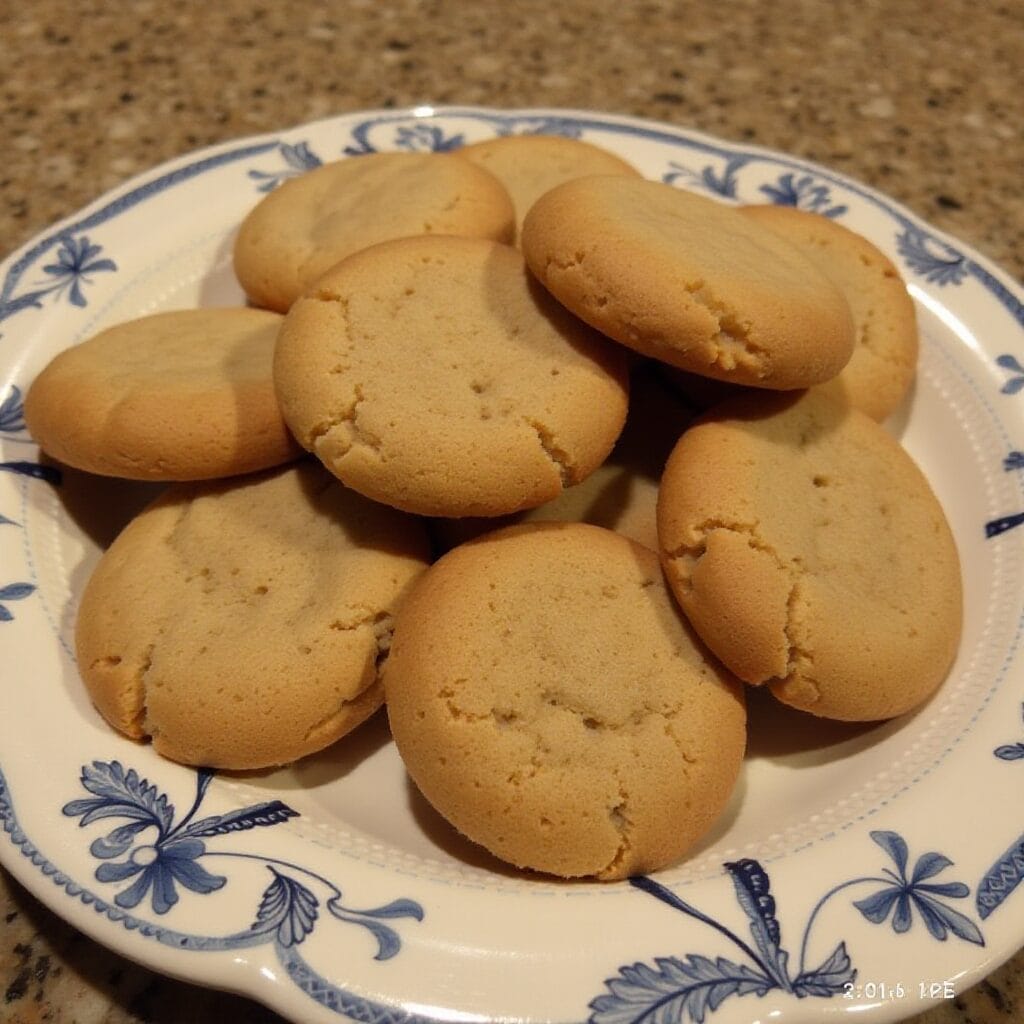How to make chewy vs crunchy cookies? I still remember my first attempt at baking the perfect cookie. The dilemma between chewiness and crunchiness is something every baker faces.
In this guide, we’ll dive into the science of cookie textures. We’ll look at the key ingredients and how to use them. You’ll learn to make chewy, crunchy, or both types of cookies. With these tips, you’ll make cookies that bring back childhood joy.

Key Takeaways
- Explore the science behind cookie texture, including the role of moisture and sugar types.
- Learn essential ingredients and their impact on cookie consistency.
- Discover the techniques for achieving perfect chewy and crispy cookies.
- Understand the importance of temperature and mixing methods in cookie baking.
- Troubleshoot common cookie texture problems and find solutions.
Understanding Cookie Texture Basics
To master cookie baking, you need to know the basics of texture. This includes the molecular structure of ingredients, moisture, and sugar types. These basics help you achieve the perfect chewiness and crispness in your cookies.
The Science Behind Cookie Structure
The texture of a cookie comes from its main parts: flour, fats, and sugars. As it bakes, flour proteins form a network that traps air and moisture. Fats melt and sugars caramelize, giving you the crunch or chewiness you want.
Role of Moisture in Cookie Texture
Moisture is key in cookie texture. Too much makes cookies soft and cake-like. Too little makes them dry and crumbly. The right amount of moisture creates a perfect balance of crisp outside and chewy inside.
Impact of Sugar Types on Cookie Consistency
The sugar type in a cookie recipe affects its texture. Granulated sugar makes cookies crisp and crunchy. Brown sugar, with more moisture, makes them chewier and softer. Knowing how sugars work with other ingredients is crucial for the right cookie consistency.

| Sugar Type | Effect on Cookie Texture |
|---|---|
| Granulated Sugar | Promotes crispness and crunch |
| Brown Sugar | Contributes to a chewier, softer texture |
| Powdered Sugar | Leads to a more tender, delicate cookie |
Understanding cookie structure, moisture, and sugar types will help you bake perfect cookies. Whether you prefer chewy or crunchy, you’ll get it right every time.
Essential Ingredients That Affect Cookie Texture
Choosing the right ingredients is key to perfecting cookie texture. From chewy to crispy, the mix of cookie ingredients greatly affects the result. Let’s explore the main elements that shape your cookies’ texture.
The Role of Flour
The type and amount of flour greatly impact cookie texture. All-purpose flour makes cookies tender and chewy. On the other hand, bread flour, with more protein, results in a crisper cookie.
Fats and Oils
The fat used, like butter, shortening, or oil, deeply affects cookie texture. Butter makes cookies soft and chewy due to its water content. Shortening or oil-based fats, however, lead to a crisper cookie.
Sugar Varieties
The kind and amount of sugar used also changes cookie texture. Granulated sugar makes cookies crisper, while brown sugar adds moisture and chewiness. Mixing different sugars can help achieve your desired texture.
Leavening Agents
Baking soda and baking powder are vital for cookie rise and structure. The right amount of these agents balances chewiness and crispiness.
Knowing how these ingredients work is crucial for making both chewy cookie recipes and crispy cookie recipes. By adjusting flour, fats, sugars, and leavening agents, you can create the perfect cookies every time.

How to Make Chewy vs Crunchy Cookies?
Getting the right cookie texture, whether chewy or crunchy, is all about balance. We’ll explore how to make both types of cookies in this section.
Steps for Perfect Chewy Cookies
For chewy cookies, use more brown sugar than white sugar. Brown sugar makes the dough moist and chewy. Also, cream the butter and sugars well to add air, making the cookies soft.
Don’t overbake the cookies. Take them out when the edges are set but the centers are still a bit soft.
Technique for Crispy Cookie Success
For crunchy cookies, use more white sugar than brown sugar. White sugar caramelizes, making the cookies crispy. Melt the butter before mixing it into the dough to help the cookies spread and become thinner.
Bake the cookies until they’re golden brown for the best crunch.
Common Texture Mistakes to Avoid
- Overmixing the dough, which can result in tough, dense cookies
- Underbaking the cookies, leading to an undercooked, gooey center
- Using too much flour, which can dry out the cookies and make them crumbly
- Baking the cookies at the wrong temperature, causing uneven baking and texture
By avoiding these mistakes and following our tips, you’ll get great results. You’ll learn how to make both chewy and crunchy cookies perfectly.
The Role of Temperature in Cookie Baking
Temperature is key when baking cookies. It can change the texture from chewy to crunchy. Knowing how temperature works can help you get the perfect cookie every time.
The cookie baking temperatures you pick affect the cookie’s texture. Hotter temperatures make cookies crispy and hard. Cooler temperatures make them soft and chewy. Finding the right temperature is all about getting the texture you want.
- For soft vs hard cookies, bake between 325°F and 375°F. Lower temperatures make cookies chewy, while higher temperatures make them crunchy.
- Make sure your oven is at the right temperature. Use an oven thermometer to check if your oven is accurate.
- Think about your cookie dough. Doughs with more fat and sugar do better at lower temperatures to avoid burning.
“The secret to perfect cookies lies in finding the right balance between temperature, time, and technique.”
Understanding cookie baking temperatures and adjusting your baking techniques can help you bake the perfect cookie. Whether you want them soft and chewy or crispy and crunchy, you can achieve it.
Mixing Methods for Different Cookie Textures
The way you mix your cookie dough can change its texture a lot. Knowing the difference between creaming and melting butter is key. Also, how well you mix the ingredients and how long you let the dough rest can affect the texture of your cookies.
Creaming vs. Melted Butter Techniques
For chewy cookie recipes, you usually cream the butter and sugar until it’s light and fluffy. This adds air, making the cookies soft and tender. But, if you melt the butter, you get a crispy cookie recipe. This method keeps the dough dense and crunchy.
Proper Ingredient Incorporation
- Mixing your ingredients just right is important for the right cookie consistency. Too much mixing can make cookies tough, while too little can mess up the ingredient mix.
- How you mix your dry and wet ingredients matters a lot. It affects the texture of your cookies.
Dough Resting Time Impact
Letting your cookie dough rest in the fridge for 30 minutes or more can really help. It lets the flour soak up better, the flavors blend, and the dough firm up. This makes your cookies turn out better and more consistent.
| Mixing Method | Cookie Texture | Recommended Dough Resting Time |
|---|---|---|
| Creaming | Chewy | 30 minutes to overnight |
| Melted Butter | Crispy | 30 minutes to overnight |
By knowing how different mixing methods and ingredient mixing affect your cookies, you can control their texture. This way, you can make the perfect chewy cookie recipes or crispy cookie recipes for everyone to enjoy.
Storage Tips to Maintain Cookie Texture
Keeping the perfect cookie texture is an art. Whether you like soft and chewy or crisp and crunchy, the right storage makes a big difference. Here are some key tips to keep your cookies fresh.
For soft and chewy cookies, keeping them moist is key. Store them in an airtight container at room temperature. Adding a slice of bread or a paper towel helps absorb moisture and prevents drying. Don’t store them in the fridge, as it can make them hard.
Crisp cookies need a different method. Store them in a container that lets air in, like a cookie tin or paper bag. This keeps them from getting soggy. If they lose crispness, try baking them at 300°F for a few minutes to revive them.
| Cookie Texture | Storage Method | Tips |
|---|---|---|
| Soft and Chewy | Airtight container at room temperature | Add a slice of bread or paper towel to absorb moisture |
| Crisp and Crunchy | Well-ventilated container (cookie tin or paper bag) | Revive stale cookies by baking at 300°F for a few minutes |
By using these simple storage tips, you can keep your cookies just right. Whether you want them soft and chewy or crisp and crunchy, it’s easy to achieve.
“The secret to perfect cookies is not just in the recipe, but in how you store them.”
Troubleshooting Common Cookie Texture Problems
Getting the perfect cookie texture can be tricky. But don’t worry, we’ve got you covered. This section will help you fix issues like hard, soft, or uneven cookies.
Fixing Overly Hard Cookies
Hard cookies might be due to overbaking or too much flour. To fix this, try baking them for a minute or two. Also, use the spoon-and-level method to measure flour accurately. Adding more butter or oil can also help soften them.
Remedies for Too-Soft Cookies
- Bake them for longer to dry out excess moisture.
- Use less milk or eggs in your recipe.
- Chill the dough for at least 30 minutes before baking.
Addressing Uneven Baking Issues
For cookies with crispy edges and soft centers, try these tips:
- Use a light-colored baking sheet to avoid over-browning.
- Rotate your baking sheet halfway through baking for even heat.
- Place your oven racks in the middle for better heat distribution.
Remember, solving cookie texture problems takes patience and practice. With a bit of experimentation, you’ll soon be baking delicious cookies every time.
Recipe Modifications for Texture Control
Getting the right cookie texture is more than just following a recipe. It’s about understanding the science behind cookie structure and the role of key ingredients. You can change existing recipes to make them chewy or crispy. Whether you like chewy cookie recipes or crispy ones, simple tweaks can make a big difference.
First, look at the ratio of cookie ingredients in your recipe. More flour and less fat make cookies crunchier. More butter or sugar makes them chewier. Swapping brown sugar for granulated sugar adds moisture and makes them softer.
| Texture Modification | Ingredient Adjustment |
|---|---|
| Chewy Cookies | – Increase brown sugar – Use more egg yolks – Reduce baking time |
| Crispy Cookies | – Increase flour – Use more granulated sugar – Bake for longer |
Also, watch how you mix and bake. Mixing gently stops gluten from forming, making cookies softer. Chilling the dough before baking helps flavors meld and gluten relax, improving texture.
With a bit of experimentation and understanding of cookie ingredients and techniques, you can change any recipe. Enjoy the art of cookie customization and discover new textures to satisfy your cravings.
“The key to perfect cookie texture is all about finding the right balance between the different ingredients and baking methods.”
Conclusion
In this article, we’ve looked into the science of cookie texture. We’ve also covered how to make chewy or crunchy cookies. You now know how to improve your cookie-making skills.
By trying out different baking techniques, changing ingredient amounts, and adjusting baking time and temperature, you can make perfect cookies. Remember, finding the perfect cookie is all about trying new things and having fun.
Whether you love chewy or crispy cookies, this guide has given you the knowledge to be a cookie expert. Use the science, trust your instincts, and show off your baking skills. Enjoy making cookies!

